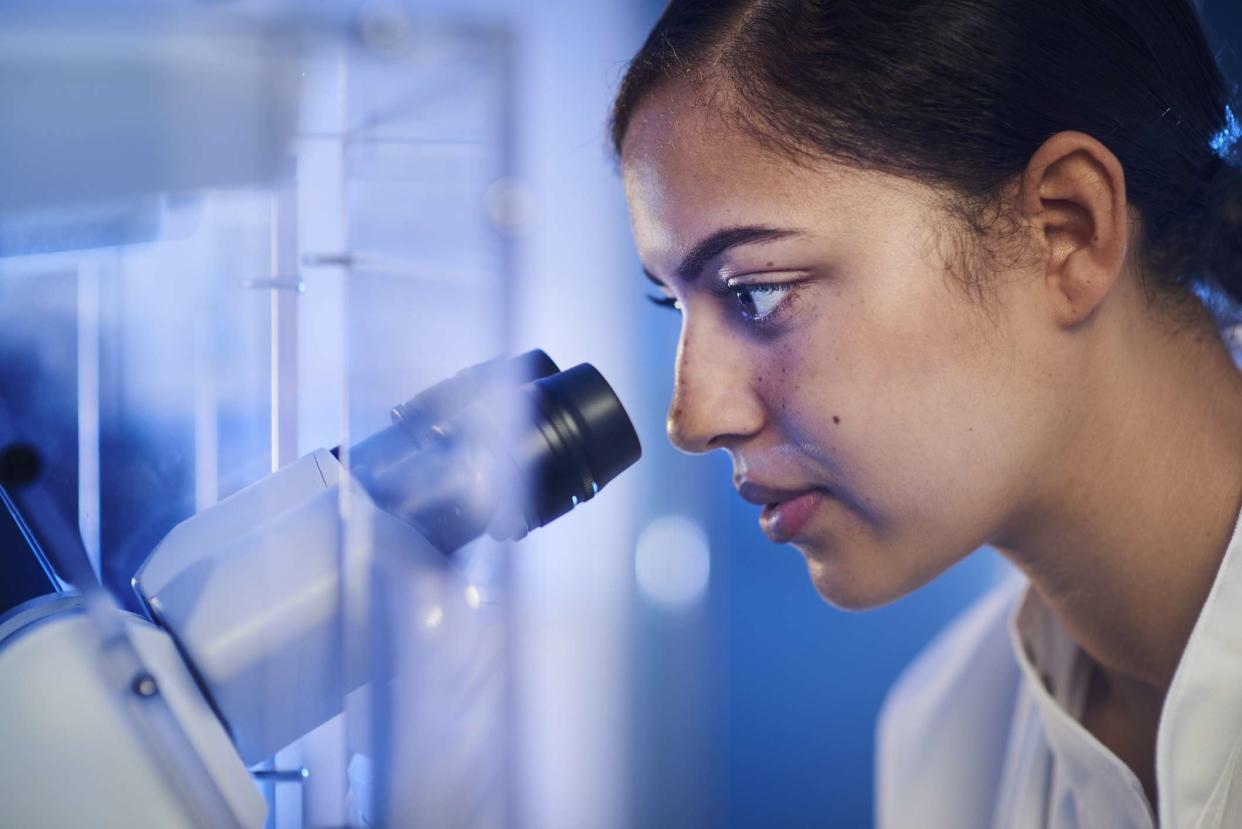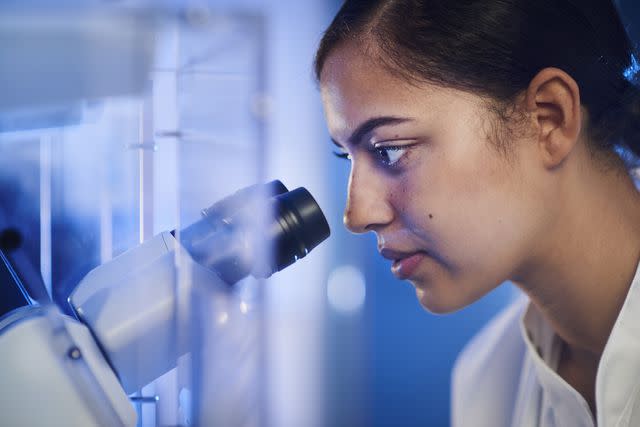Porokeratosis: What’s the Risk of Cancer?

Matt Lincoln / Getty Images
Medically reviewed by William Truswell, MD
"Porokeratosis" refers to a group of rare skin diseases that result in an overabundance of a protein called keratin. These ailments cause small, scaly papules (raised bumps) that have a thin, raised border that is white, yellow, or brown. The bumps can occur alone or expand to create patches.
This disease can be caused by genetic or acquired factors. Bumps often appear on your arms and legs, though they can occur on any part of your body. They can happen in one section or spread to more than one area.
Treatment is often not needed, though itchy bumps can be relieved. It is also possible to remove the bumps. Though rare, porokeratosis can become malignant (cancerous).
This article describes porokeratosis causes, symptoms, and diagnosis. It also covers the need for treatment and what can be done.

Matt Lincoln / Getty Images
Link Between Porokeratosis and Cancer
While the general prognosis for most people with porokeratosis is good, research indicates that the disease can be precancerous. Studies show that the skin changes can create a high risk of skin cancer for those affected.
Research indicates that 6.9% to 11.6% of porokeratosis cases develop into skin cancer. The most common type of skin cancer to occur from porokeratosis is squamous cell carcinoma, though it is also linked with basal cell carcinoma and melanoma.
The risk of skin cancer for porokeratosis is low overall. Of the six subtypes of porokeratosis, the highest risk of becoming skin cancer exists with the disseminated superficial actinic porokeratosis (DSAP) variant. Skin cancer has also resulted from porokeratosis of Mibelli and linear porokeratosis.
Learn More: What Does Skin Cancer Look Like?
Causes: Why Does Porokeratosis Form?
The specific cause of porokeratosis is unknown. It is thought to occur from an abnormal reproduction of keratinocytes—cells that make up the majority of your epidermis (the outermost layer of your skin). It is not a contagious condition.
The following characteristics are regarded as risk factors for porokeratosis:
Genetics
Exposure to sunlight and other forms of ultraviolet (UV) radiation
Immunosuppression (weakened immune system due to infection, drugs, or inflammatory and/or autoimmune disease)
Infectious agents such as hepatitis C virus (HCV), herpes simplex virus, and human papillomavirus (HPV)
Systemic diseases such Crohn's disease, chronic liver disease, chronic kidney failure, rheumatoid arthritis, ankylosing spondylitis, and diabetes mellitus
Hematologic malignancies or solid organ tumors
Traumatic factors such as burns or wounds
Certain drugs such as Microzide (hydrochlorothiazide), Garamycin (gentamicin), Enbrel (etanercept), Cimzia (certolizumab pegol), and Herceptin (trastuzumab)
How Different Types of Porokeratosis Look
There are six types of porokeratosis. Symptoms for each variant include the following:
Classic porokeratosis of Mibelli characteristics include:
Generally affects children or young adults (more common in males than females)
Begins as one or a few small, brownish bumps
Develops into raised, bumpy patches that increase in size over time
Patches show a prominent border with a thin ridge with white, yellow, or brown edges that are easily identified
Lesions located on your trunk or a limb, though they can develop anywhere
Pruritus (abnormal itching)
Skin atrophy (erosion of epidermis, resulting in lax, wrinkled, and shiny skin with visible underlying veins)
Hyperkeratosis (a skin condition in which the outer layer of skin becomes thick and hard due to too much keratin)
Disseminated superficial porokeratosis (DSP) characteristics include:
Generally affects children ages 5 to 10 years
Ring-shaped brownish lesions on both sun- and non-sun-exposed areas
Numerous skin lesions, mainly on the trunk, genitals, and ends of the arms and legs
Lesions can appear bilateral and symmetrical
Pruritus
Hyperkeratosis
Skin atrophy
Disseminated superficial actinic porokeratosis (DSAP) characteristics include:
Generally affects adults in their 30s and 40s (more common in females than males)
Multiple small, round, pink to reddish brown lesions that can total in the hundreds
Lesions present on any part of the body, though most often on the arms, legs, shoulders, or back
Severe pruritus and/or stinging
Skin patches with a scaly appearance
Symptoms worsen during the summer or after phototherapy
Porokeratosis palmaris et plantaris disseminata (PPPD) characteristics include:
Generally affects adolescents and young adults (more common in males than females)
Small, skin-colored lesions that are flat and may merge with surrounding skin
Lesions may have yellow pits in their center
Lesions are often bilateral and symmetrical
Numerous lesions measuring 1 to 2 millimeters (mm) on your palms and soles, possibly spreading to affect larger areas
May also include DSAP-like lesions on your trunk and limbs or mucous membranes
Skin atrophy
Possible painful lesions
Linear porokeratosis (LP) characteristics include:
Generally affects children and occasionally adults (more common in females than males)
Multiple small reddish-pink skin lesions, usually limited to small areas of your body
Formation of lesions in a linear distribution on your extremities
Lesions that start on your palms and soles but spread to other parts of your body
Skin atrophy
Pruritus
Punctate porokeratosis (PP) characteristics include:
Generally affects adolescents and young adults
Multiple seed-like lesions that measure 1 to 2 mm on your palms and soles
Depressed or raised lesions
Linear or diffused pattern to lesion placement
Pruritus or tenderness
Possibly present with other forms of porokeratosis
Porokeratosis vs. Ringworm
The lesions caused by porokeratosis are round with a border that can be confused with ringworm. However, these conditions differ in the following ways:
Porokeratosis;
Caused by genetics or acquired by factors related to sun exposure
Not contagious
Center bump that is pink to brown
Symptom relief with dermatologist-prescribed therapies or procedures
Ringworm:
Caused by a fungus
Highly contagious through skin-to-skin contact
The center bump is the same color or slightly lighter than your skin color
Treatable at home with an over-the-counter antifungal cream
Biopsy to Diagnose Porokeratosis
The hallmark of all types of porokeratosis is the coronoid lamella, the thin raised edge that surrounds a lesion. A diagnosis can be made if the coronoid lamella is present.
A dermatologist (a physician specializing in skin conditions) can usually make a diagnosis based on the presence of the coronoid lamella, a visual examination, and the use of dermoscopy (a skin examination using a handheld magnifying device called a dermatoscope used to diagnose skin cancer).
However, a skin biopsy is sometimes used to achieve a definitive diagnosis if there is any doubt. A biopsy can also be helpful if a spot has characteristics such as crusting, redness, or scaling that may indicate that it poses a risk of skin cancer.
When a biopsy is performed, a sample is taken from the border of the lesion. When porokeratosis exists, the sample shows cells from the coronoid lamella.
How to Protect Skin With Porokeratosis
While multiple treatments are used for porokeratosis, there are no treatment standards. Treatment is individualized based on a person's functional and aesthetic concerns.
If you have a diagnosis of porokeratosis, it is important to follow up with a dermatologist to monitor your lesions in case they become cancerous. You should also avoid additional damage to the affected area so you don't aggravate the condition.
The following strategies can help protect skin that is diagnosed with porokeratosis:
Avoid exposure to the sun between the hours of 10 a.m. and 4 p.m., when the sun is strongest.
Apply sunscreen with a sun protection factor (SPF) of 30 or higher daily, regardless of the weather.
Reapply sunscreen every two hours and after swimming or sweating heavily.
Remain in the shade of an umbrella, tree, or other type of shelter when you are outside during daylight hours.
Wear a hat, long-sleeved shirts, and long pants out in the sun.
Choose clothing with tightly woven materials, which provide greater protection from the sun.
Avoid reflective surfaces like sand, water, and concrete that can reflect more than half of the sun's rays onto your skin.
Do not use tanning parlors since the ultraviolet (UV) light emitted by tanning booths can increase your risk of skin cancer.
There is no evidence that home remedies can cure porokeratosis. You may achieve some symptom relief with the use of emollients, which can help soften the appearance and texture of rough, hard lesions. Consult with your dermatologist for additional treatment options.
Treatment for Porokeratosis at the Dermatologist
Mild cases of porokeratosis do not require treatment. Treatment for porokeratosis is elective. It is usually done to treat discomfort and/or cosmetic concerns. While treatments are effective, achieving full remission (absence of disease symptoms) can be challenging.
Responses to different treatments vary by individual and are usually temporary. Only about 16% of people treated achieve a complete response. Relapses are common.
The best way to treat your condition may depend on the type of porokeratosis you have. The following treatments for porokeratosis are some of the most commonly used options available from your dermatologist:
Topicals:
Vitamin D3 analogues: Calcipotriol (calcipotriene), Curatoderm (tacalcitol)
Topical retinoids: Retin-A (tretinoin topical), Tazorac (tazarotene topical)
Oral medication:
RetinoidsL Soriatane (acitretin), isotretinoin
Kepivance (palifermin)
Corticosteroids: Deltasone (prednisone), Decadron (dexamethasone)
Neoral/Gengraf (cyclosporine)
Procedures:
Cryotherapy (freezing a lesion)
Electrodesiccation and curettage (scraping and burning away lesions)
Dermabrasion (using rough particles to rub away a lesion)
Laser therapy (treatment with a directed narrow beam of light)
Photodynamic therapy (light treatments)
Surgical aspiration with ultrasound
Summary
Porokeratosis includes a group of diseases that cause small, scaly lesions on your skin. These round bumps can grow alone or in patches. They are defined by a raised border and can become itchy.
This group of skin conditions can be present at birth or acquired. Risk factors include exposure to UV light, a weakened immune system, infections, certain drugs, and trauma to your skin.
There is no cure for porokeratosis. Treatment for mild cases is not needed. Therapy is geared toward relieving symptoms such as itching. It can also help improve appearance by reducing the number of lesions, though recurrence is common.

